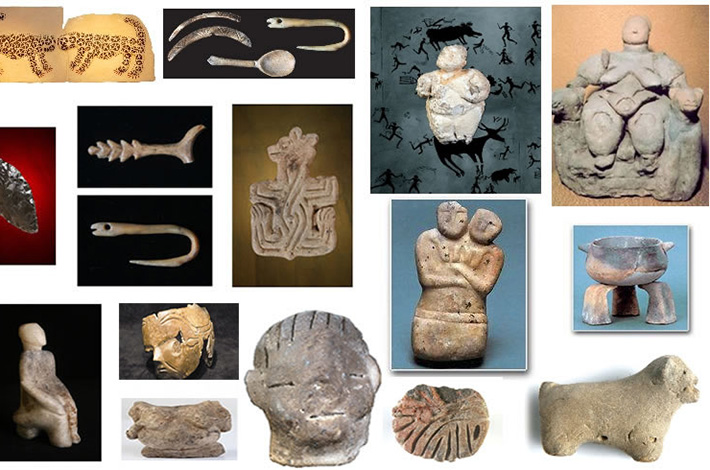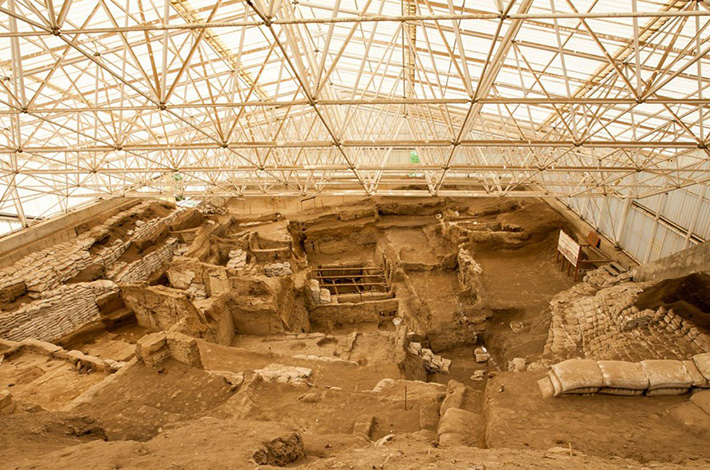Çatalhöyük is a globally renowned archaeological settlement located near Küçükköy, 11 km north of Çumra district of Konya in Turkey. The settlement was discovered in 1958 by James Mellaart, an archaeologist from the British Archaeological Institute, and two of his companions. Between 1962 and 1965, Mellaart conducted excavations that uncovered the remains of a settlement dating back to about 9 thousand years ago. Between 1993 and 2018, an international team led by Ian Hodder, a prominent archaeologist in the field of archaeological theory, conducted excavations and research at Çatalhöyük. The second period of excavations at Çatalhöyük produced significant results on various topics, including the environment, gender relations, family dynamics, mythology, and daily life. The area surrounding Çatalhöyük is abundant with resources, including the Çarşamba Stream which, although dry today, flows at the base of the mound. Additionally, the neighbourhood is rich in obsidian deposits, a crucial raw material for tool-making during that time. This obsidian was even exported to Cyprus, Israel, Palestine, and Mesopotamia. Çatalhöyük was founded as a small village approximately 9,000 years ago. Over time, it grew into a large settlement with a population of 3,000 to 8,000 people, taking advantage of the opportunities provided by the environment. In this respect, Çatalhöyük is one of the settlements that best reflects the early process of civilisation. One of the distinctive features of Çatalhöyük is its unique architecture. The mudbrick houses are comprised of a central room and two to three surrounding rooms. Access to the houses is via wooden stairs through a hole in the roof. The central room, which contains the hearth, serves as the focal point of the house and daily life. In addition to the hearth, there are several benches or platforms in the central room. The surrounding rooms are typically used as cellars. The houses in Çatalhöyük were built without leaving any gaps, such as streets or courtyards, resulting in house islands that resemble a honeycomb. The interiors of these houses are filled with works of art, including paintings, reliefs, and sculptures that reflect the beliefs of the society. Many of the walls are decorated with panels depicting scenes of bull and deer hunting, vultures, leopard figures, hand prints, and geometric patterns. Bovine skulls and horns, obtained from wild bulls, were coated with clay and affixed to walls or benches. Teeth, skulls and bones of wild boars, foxes, vultures, etc. were inserted inside the walls. Mellaart suggests that certain structures may have had a temple function. One of these structures has been moved to the Museum of Anatolian Civilisations in Ankara and is still on display there. Çatalhöyük features burial pits beneath the floors of many houses. These pits contain both single burials and mass graves with over 10 human skeletons. The dead were typically placed in the fetal (hocker) position and wrapped in cloth, with burial gifts such as beads, necklaces, pots, and bowls left beside them. The practices surrounding the dead suggest that they held a significant place in the beliefs of Çatalhöyük society. Among the remarkable discoveries from Çatalhöyük are statuettes of women with exaggerated hips and breasts. The statue of a woman seated on a throne with wild animals on either side has been interpreted by many scholars since its discovery in the 1960s as a 'mother goddess', possibly a forerunner of Cybele. Recent research has shown that the social status of men and women in the settlement was not very different, dispelling the idea that Çatalhöyük was a matriarchal society. The Anatolian Civilisations Museum and the Konya Archaeological Museum exhibit excellent examples of the statuettes that sparked these debates. Çatalhöyük was inscribed on the UNESCO World Heritage List in 2012 for its exceptional architecture, social order, and contribution to the understanding of the Neolithic period.
ÇATALHÖYÜK ARCHAEOLOGICAL SITE





